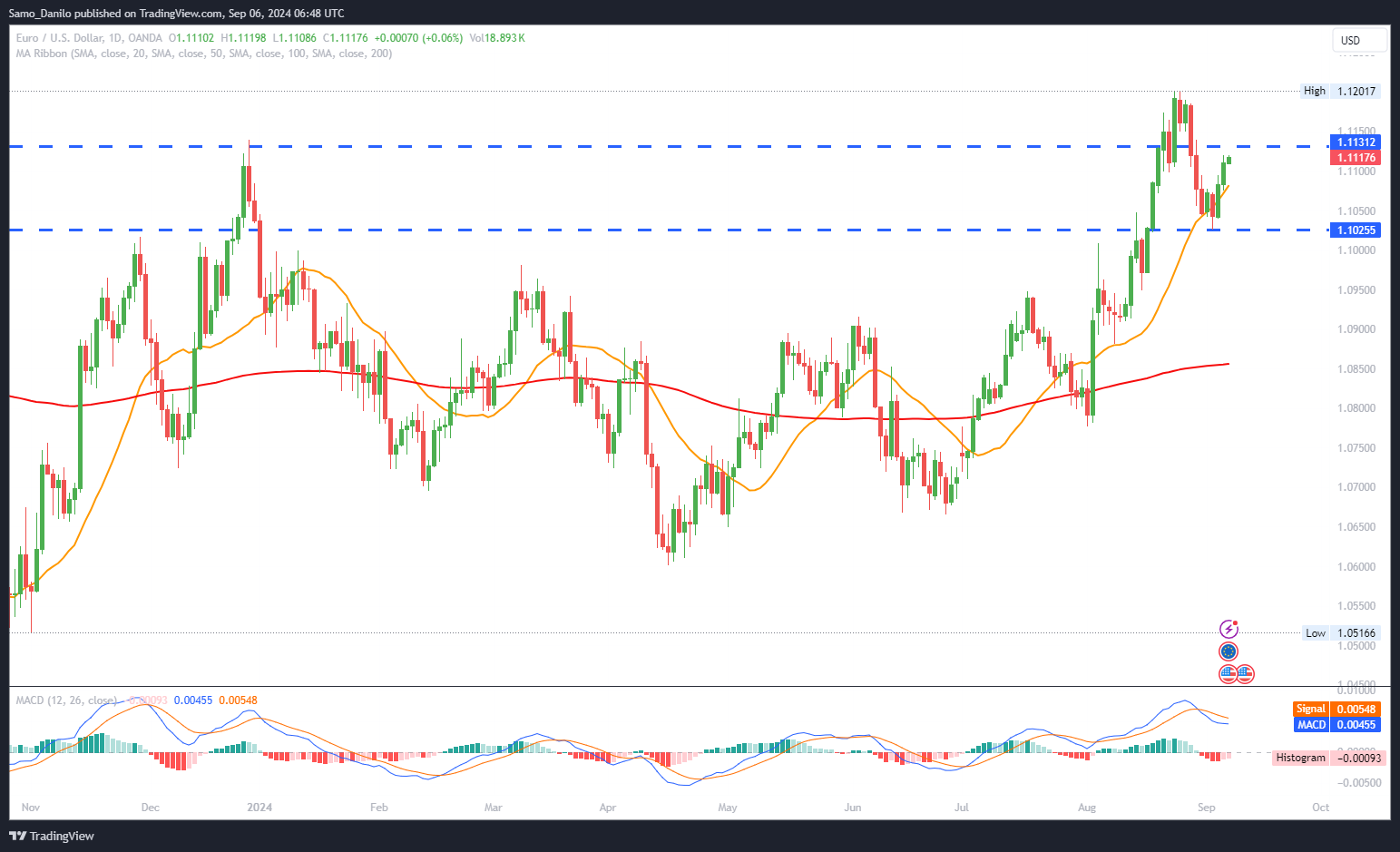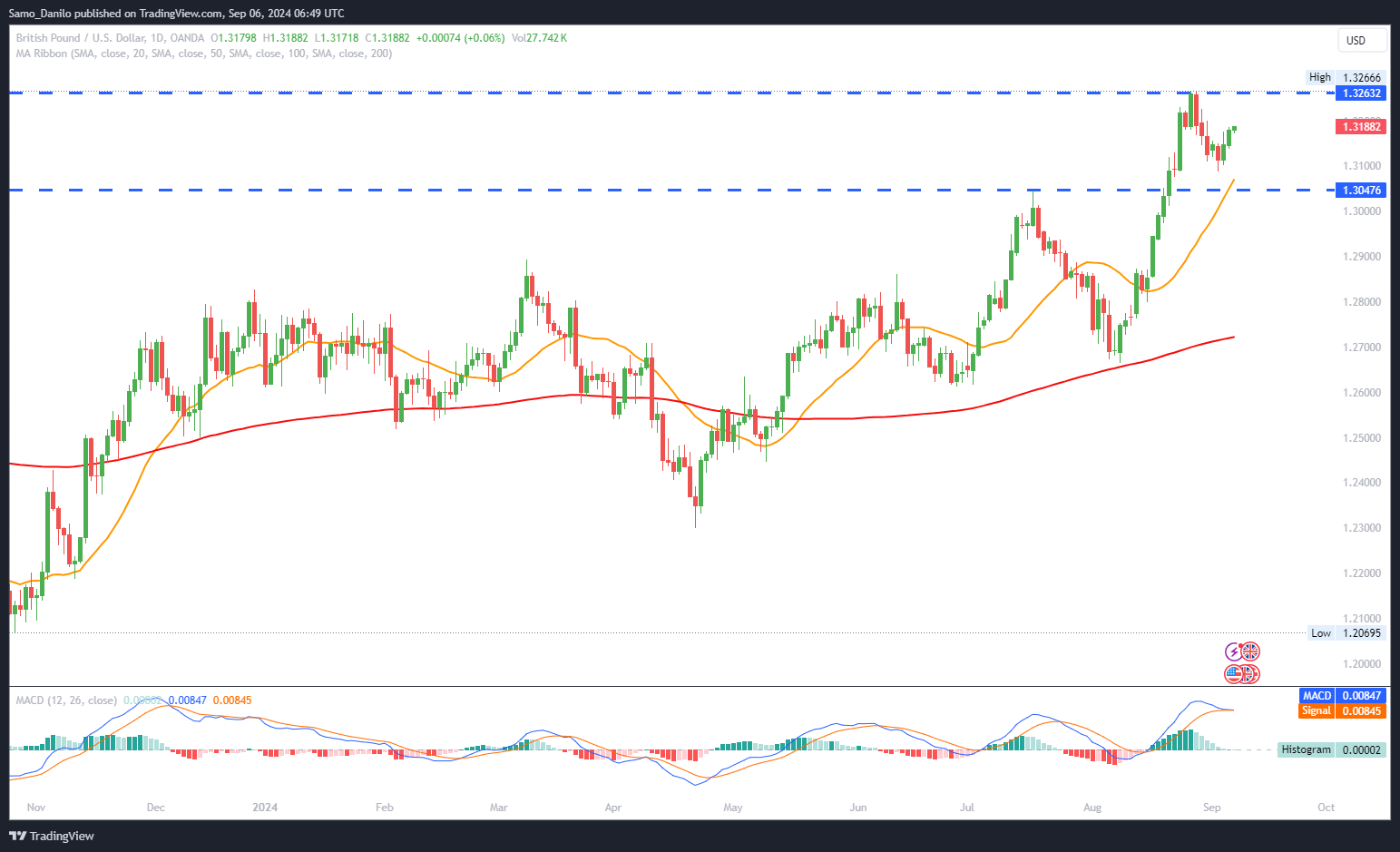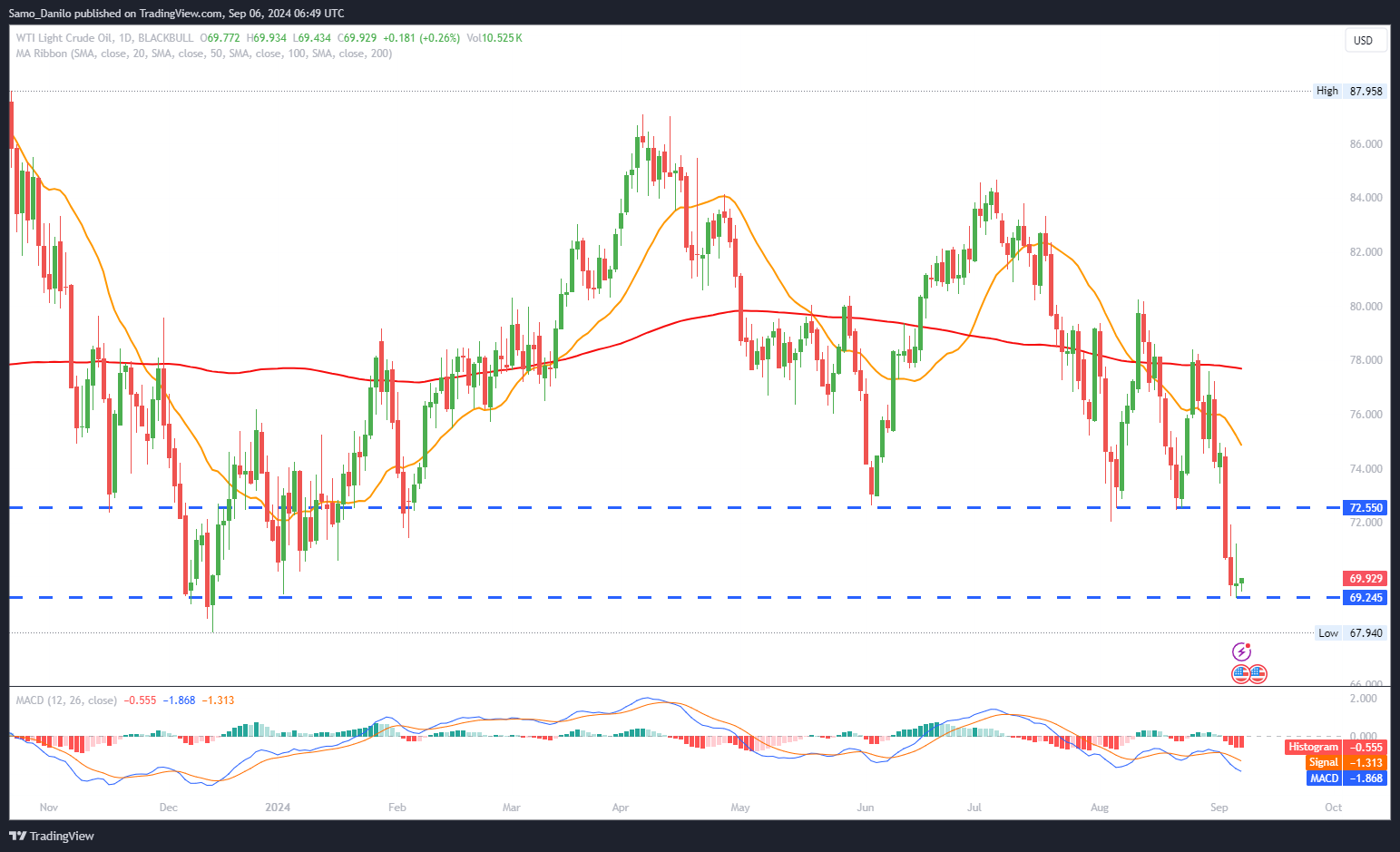EURUSD
- EUR/USD Gains: The pair continued its upward momentum for the second consecutive session, breaking above the 1.1100 barrier and reaching multi-day highs. The rally was largely driven by a bearish tone in the US Dollar, which helped lift the euro.
- Technical Outlook: From a technical perspective, the EUR/USD's recovery from the 1.1075-1.1070 region—marking a two-week low hit earlier on Tuesday—has stalled near the 50% Fibonacci retracement level. This retracement level corresponds to the recent corrective slide from the year-to-date (YTD) peak reached in August. Traders may be watching for further resistance around this level, which could dictate near-term price action.
- Nonfarm Payrolls Data: On Friday, the United States Bureau of Labor Statistics (BLS) will release the much-anticipated Nonfarm Payrolls (NFP) report for August. This data will be crucial in offering insights into the strength of the US labour market, which could significantly influence the Federal Reserve's upcoming rate decisions.
- Fed Rate Outlook: The August employment figures will play a pivotal role in shaping expectations for the Fed's September 17-18 policy meeting. Strong labour data could dampen expectations for aggressive rate cuts, while weaker figures could support a more dovish stance from the central bank.
- Fed’s Dual Mandate: In its July policy statement, the Federal Reserve tweaked its language to reflect attentiveness to risks on both sides of its dual mandate, namely inflation and employment. Previously, the Fed had been primarily focused on inflation risks, but the new statement suggests a broader consideration of economic conditions, which could influence market expectations regarding future monetary policy.
Closing statement: The EUR/USD's performance in the coming days will be closely tied to the outcome of Friday's NFP report. Strong labour data could reinvigorate the US Dollar, potentially halting the EUR/USD rally, while disappointing figures may further weaken the Greenback, providing additional upward momentum for the euro. Traders will also be watching the 50% Fibonacci retracement level for potential resistance, as a break above this point could signal continued bullish momentum in the near term.
GBPUSD
- GBP/USD Rally: The GBP/USD pair advanced for the second consecutive session on Thursday, signalling a potential bullish recovery. However, despite the positive momentum, the pair failed to reclaim the 1.3200 psychological level, indicating that further gains may face resistance at this point.
- US Jobs Data (ADP): The ADP report released on Thursday showed that the US economy added 99,000 jobs in August, significantly lower than July's revised 111,000 and far below the forecasted 145,000. This is the lowest job addition figure reported by ADP since early 2021, suggesting potential weakness in the US labour market.
- Upcoming Nonfarm Payrolls: Later Friday, the US Bureau of Labor Statistics will publish the key Nonfarm Payrolls (NFP) report for August. The market consensus is expecting 160,000 job additions. This data will be crucial in shaping expectations for the Federal Reserve’s next policy move, particularly with concerns over slowing labour market growth.
- BoE Rate Outlook: Bank of England (BoE) Governor Andrew Bailey, in a statement last month, indicated that long-term inflation pressures might be easing. However, he also cautioned that it is still too early to declare a definitive victory over inflation, signalling that the BoE would not rush into further rate cuts.
- BoE Rate Cut Probability: Market participants see a 25% chance that the BoE will cut interest rates at its September 12 policy meeting. Although a rate cut in September is less likely, a cut is fully priced in for the November meeting, reflecting the market's expectation of a shift in the BoE’s monetary policy later in the year.
| SMA (20) | Rising |
|
|
| RSI (14) | Slightly Rising |
| |
| MACD (12, 26, 9) | Slightly Rising |
|
Closing statement: The trajectory of the GBP/USD pair will depend heavily on Friday’s US Nonfarm Payrolls report. Strong labour market data could revive demand for the US Dollar, potentially limiting the GBP/USD upside, while weaker-than-expected figures could support further gains in the pound. The 1.3200 level will remain a key resistance point, and a break above it would suggest stronger bullish momentum. Additionally, the evolving outlook for both the Fed and BoE’s monetary policies will continue to influence market sentiment in the coming weeks.
GOLD
- Gold Rally: Gold prices (XAU/USD) climbed closer to the significant $2,524-$2,525 resistance zone on Thursday, buoyed by persistent selling pressure on the US Dollar. The weakening greenback helped boost demand for the yellow metal, as investors sought safe-haven assets amid broader market uncertainty.
- ADP Employment Data: The ADP National Employment Report revealed that US private-sector employment rose by 99,000 in August, marking the smallest increase since January 2021. The disappointing data suggested that the US labor market might be losing steam, raising concerns about the overall health of the economy. This supported the gold price, as weaker employment figures tend to lower expectations for aggressive Federal Reserve action.
- Labor Market Concerns: Throughout the week, a series of mixed US employment reports fueled worries about the strength of the US labor market. While the decline in the ADP figures was notable, earlier JOLTS data also showed fewer job openings. This combination of soft data further bolstered the appeal of gold as a hedge against economic downturns.
- Geopolitical Tensions: Persistent geopolitical tensions globally also underpinned demand for gold, a traditional safe-haven asset. Continued uncertainty in various regions, including the ongoing conflicts and global trade issues, have prompted investors to allocate more toward safe assets like gold, adding further support to prices.
- Nonfarm Payrolls (NFP) Report: The market is now eagerly awaiting Friday's Nonfarm Payrolls (NFP) report, which will be pivotal in shaping expectations for the Federal Reserve's monetary policy. Should the NFP data point to further labor market weakness, it would likely reinforce expectations for a rate cut by the Fed, further supporting the gold price. Conversely, stronger-than-expected job numbers could weigh on gold, as it would reduce the urgency for rate cuts.
| SMA (20) | Rising |
|
|
| RSI (14) | Slightly Rising |
| |
| MACD (12, 26, 9) | Slightly Rising |
|
Closing statement: Gold prices are likely to remain sensitive to Friday’s NFP data, which could determine whether the precious metal can break above the $2,524-$2,525 supply zone. A weaker-than-expected NFP reading could push gold prices higher, as it would solidify expectations for the Fed to adopt a more dovish policy stance. However, if the NFP surprises to the upside, gold could face renewed selling pressure. For now, safe-haven demand and a weak labour market outlook are providing strong support for XAU/USD, with geopolitical tensions adding another layer of bullish momentum.
CRUDE OIL
- Price Decline: West Texas Intermediate (WTI) crude oil is trading around $69.40 on Friday, hovering near its lowest level since December 2023, recorded on Thursday. The sharp decline reflects ongoing concerns about global demand, particularly from the world's two largest consumers—the United States and China. These demand fears are a primary driver of the bearish sentiment in oil markets.
- Demand Concerns: US and China demand worries continue to weigh on oil prices. China's recent weak economic data, coupled with ongoing concerns about slowing growth in the US, has led to a pessimistic outlook for crude demand in the coming months. Traders are increasingly concerned that the two economies' slowing activity could limit oil consumption, further pressuring prices.
- EIA Data: On Thursday, the US Energy Information Administration (EIA) reported a significant reduction in crude oil inventories, with a 6.873 million barrel drawdown for the week ending August 30. Typically, such a large inventory draw would support oil prices, but the market's focus remains squarely on the broader demand outlook, overshadowing the bullish supply data.
- OPEC+ Output Plans: Despite the recent price drop, oil prices could find some support from ongoing discussions within OPEC+ regarding a potential delay in planned output increases. The group, led by Russia and Saudi Arabia, was originally scheduled to increase production in October. However, with demand concerns looming, OPEC+ is now considering delaying this output boost to prevent further downward pressure on prices.
- Fed Comments: Dovish comments from Federal Reserve (Fed) officials have raised the chances of a more aggressive rate cut in September. This has sparked hopes that lower interest rates might support economic growth and energy demand in the medium term. As a result, this is offering some near-term relief for WTI prices, helping to mitigate further downside despite the broader bearish outlook.
| SMA (20) | Falling |
|
|
| RSI (14) | Falling |
|
|
| MACD (12, 26, 9) | Falling |
|
|
Closing statement: WTI crude oil prices are caught between demand concerns and potential supply-side adjustments from OPEC+. While the market remains pressured by weak demand signals from both the US and China, the large crude inventory draw and the possibility of OPEC+ delaying output increases could help limit further downside. Moreover, the prospect of Fed rate cuts could boost sentiment and support WTI prices in the coming weeks. However, any sustained recovery will likely depend on improvements in the demand outlook from the world's major oil-consuming economies.
DAX
- Market Movers: SAP and Infineon Technologies continued to extend their losses from Wednesday, weighed down by growing concerns over a potential recession. These fears hit tech-related stocks particularly hard, as growth-sensitive sectors faced significant pressure. Additionally, recession worries have also impacted demand for retail stocks, contributing to the broader decline in the DAX index.
- Factory Orders Boost: German factory orders provided a surprising 2.9% increase in July, following an even stronger 4.6% rise in June. The positive momentum in factory orders offered early optimism, suggesting a potential improvement in demand within the industrial sector. Despite concerns over growth, the boost in factory orders hints at some resilience in certain parts of the economy.
- Industrial Production Shrinks: Despite the positive factory orders data, Germany’s industrial production fell sharply by 2.4% month-over-month in July, significantly worse than market expectations of a 0.3% decline. The contraction in industrial output reflects ongoing struggles in Germany's manufacturing sector, which continues to face challenges from slowing global demand and domestic economic headwinds.
- Trade Surplus Decline: The German trade surplus also narrowed in July, with a seasonally adjusted surplus of €16.8 billion, down from €20.4 billion in the previous month. The shrinking trade surplus is another sign of potential weakening in external demand, adding to concerns over the outlook for Germany's export-driven economy.
- US Jobs Report: Investors are closely watching the release of the US Nonfarm Payrolls (NFP) report on Friday, which will be a critical indicator for global markets. Stronger-than-expected US labor market data could fuel consumer spending and provide further support for the US economy. However, tighter labor market conditions could also lead to wage growth pressures, raising concerns over inflation and the potential for continued interest rate hikes by the Federal Reserve.
| SMA (20) | Slightly Rising |
|
| RSI (14) | Slightly Falling |
|
| MACD (12, 26, 9) | Slightly Rising |
|
Closing statement: The DAX is struggling under the weight of recession fears and poor industrial production data, particularly impacting tech and retail stocks. While the surprise rise in factory orders offers a glimmer of hope for future demand, broader concerns about slowing growth and weakening external demand remain. The outcome of the US Jobs Report on Friday will be pivotal, as it could shape global market sentiment and provide insights into the strength of the US economy, with potential ripple effects on European markets.




